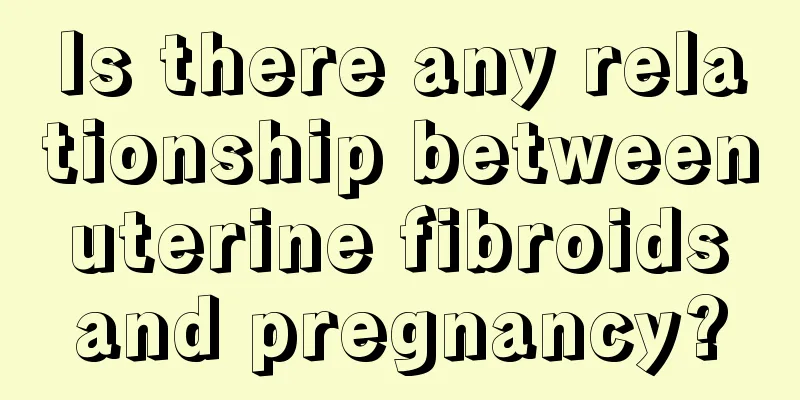Is there any relationship between uterine fibroids and pregnancy?

|
Uterine fibroids are a common gynecological disease. If the area of the fibroids is relatively large and is not thoroughly treated, it will cause the uterine fibroids to rupture, which will pose a greater threat to our body. Regarding the issue of uterine fibroids and pregnancy, it is related to the size of the fibroid area and the part where it grows, but infertility caused by uterine fibroids is also very common. Can I get pregnant with uterine fibroids? Uterine fibroids are very harmful to fertility. When the fibroids grow to a certain size, they will compress the fallopian tubes, affect the movement of sperm and eggs, and cause infertility. If the location of the growth of the fibroids is such that pregnancy is possible, the fibroids will grow along with the growth of the uterus during pregnancy, especially after the second trimester, when they will grow rapidly and "degenerate", causing symptoms such as abdominal pain and fever. Uterine fibroids can also easily cause miscarriage and premature birth. So, is it possible to get pregnant with uterine fibroids? Women with uterine fibroids can get pregnant, but it will reduce the success rate of pregnancy. However, patients with uterine fibroids can get pregnant. Uterine fibroids complicated by pregnancy account for 0.5%-1% of fibroid patients. The impact of uterine fibroids on pregnancy and delivery is related to the type and size of the fibroids. 1. Miscarriage. Submucosal fibroids can affect the implantation of the fertilized egg and lead to early miscarriage; excessively large intramural fibroids can cause deformation of the uterine cavity or insufficient blood supply to the endometrium, leading to miscarriage. 2. Abnormal fetal position. Fibroids that grow in a lower position can hinder the descent of the fetal presenting part, resulting in abnormal fetal position, low-lying or previa placenta, birth canal obstruction, etc. in late pregnancy and during delivery. 3. Postpartum hemorrhage. After the fetus is delivered, postpartum hemorrhage is likely to occur due to placental adhesion, large attachment surface or difficulty in expulsion, and poor uterine contraction. Pregnancy complicated by uterine fibroids can usually result in natural delivery, but postpartum hemorrhage should be prevented. If the fibroids hinder the descent of the fetus and a hard cesarean section is required, whether the fibroids should be removed during the operation depends on the size and location of the fibroids and the patient's condition. Symptoms of uterine fibroids The symptoms of uterine fibroids mainly include irregular menstruation, lumps in the lower abdomen, increased vaginal discharge, compression symptoms, back pain, etc. If you find these symptoms, you should take them seriously to avoid worsening of the condition and affecting the treatment effect. Symptoms of uterine fibroids include the following: 1. Irregular menstruation Irregular menstruation with increased menstrual flow and prolonged menstrual period is the most common symptom of uterine fibroids. It is more common in large intramural fibroids and submucosal fibroids. Fibroids enlarge the uterine cavity, increase the area of the endometrium and affect uterine contraction. In addition, fibroids may compress the veins near the tumor, causing congestion and dilation of the endometrial venous plexus, thereby causing increased menstrual flow and prolonged menstruation. When submucosal fibroids are accompanied by necrosis and infection, there may be irregular vaginal bleeding or bloody purulent discharge. Long-term excessive menstrual flow may lead to anemia, fatigue, palpitations and other symptoms. 2. Lower abdominal mass When the fibroids are small, no lump can be felt in the abdomen. However, when the fibroids gradually increase in size and the uterus exceeds the size of a 3-month pregnancy, they can be felt from the abdomen. Huge submucosal fibroids can prolapse outside the vagina, and patients may seek medical attention due to prolapse of the vulva. 3. Increased leucorrhea Intramural fibroids increase the area of the uterine cavity, increase the secretion of endometrial glands, and are accompanied by pelvic congestion, which leads to increased leucorrhea. Once submucosal uterine fibroids are infected, there may be a large amount of pus-like leucorrhea. If there is ulceration, necrosis, or bleeding, there may be bloody or purulent vaginal discharge with a foul odor. |
<<: Is it normal for the fetus to move below the belly button?
>>: Signs of second childbirth a few days before
Recommend
What is the hcg value at 31 days of pregnancy
Pregnancy must be the most unforgettable event in...
16-year-old girl breast pain why
After a happy childhood, our height and weight wi...
Is injection useful for irregular menstruation?
Irregular menstruation is a common gynecological ...
What is vaginal contact bleeding?
Many women will suffer from gynecological inflamm...
Is it ok to get pregnant with herpes simplex virus type 1?
Many of my friends don’t know much about herpes s...
Is it normal to have less lochia after childbirth?
Generally, there will be lochia after giving birt...
Can a severed limb that has run away from home be found again?
Friends who have watched "Douluo Dalu" ...
Breast Cancer: Understanding and Conquering
Breast cancer, as a common malignant tumor, has a...
What's wrong with a girl's bulge in the middle?
The structure of a woman's vagina is relative...
Popular Science | Antimicrobial Coatings for Medical Devices
The third issue of the "Popular Science Seri...
What are the symptoms of pregnancy in the first three days?
The first three days of pregnancy belong to the e...
What should you pay attention to when bleeding after a miscarriage
Everyone knows that bleeding will occur after a m...
Signs of irregular menstruation, scanty menstruation, amenorrhea, and premature menopause
Menstrual irregularities must attract women's...
Drinking soy milk and coffee can cause breast cancer? This is a common health rumor. Share it with your mother!
Today is Mother's Day. While thanking mothers...
What is the cause of the nipple lump?
Breast problems have appeared more frequently and...









